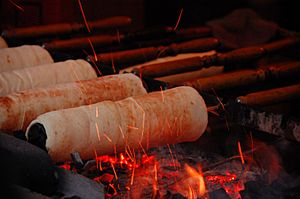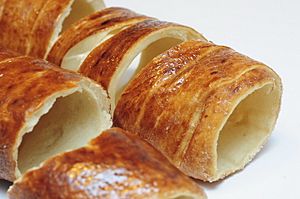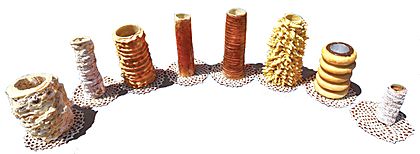Spit cake facts for kids
A spit cake is a special kind of cake that is cooked on a spinning stick. Imagine a long, round stick turning slowly over a fire or in a special oven. Layers of dough or batter are added to the stick, one at a time. This makes the cake cook evenly all around.
Spit cakes are often made for big celebrations. These include events like weddings or Christmas. The dough can be thin and liquid, so the stick is dipped into it many times. Or, the dough can be thicker and wrapped around the stick in a spiral.
These cakes might be very old! Some people think they first appeared around 400 BC. Back then, large cakes were cooked on spits for ancient Greek parties. An old Greek writer named Athenaeus wrote about different breads and cakes. He mentioned rolls that were baked on a spit.
Contents
How Spit Cakes Are Made

Making a spit cake is a bit like magic, but it takes time and effort! The main idea is always the same. Dough is put onto a stick, which slowly spins over a heat source. This could be an open fire or a special oven.
One way to make it is by dipping the spinning stick into a bowl of liquid dough. Each time the stick is dipped, a new layer of dough sticks to it. As it cooks, these layers build up. If the dough is very runny, it might drip. This creates cool, spiky shapes on the cake, making it look a bit like coral. When you cut this type of cake, you see many rings inside. That's why some people call it a "tree cake"!
Another way is to wrap the dough around the stick in a long spiral. Some spit cakes look smooth on the outside. Others, like spettekaka or šakotis, have a more bumpy or spiky shape.
Different Kinds of Spit Cakes
Many countries and cultures have their own unique spit cakes. They are all special because they take a lot of work to make. This makes them perfect for big events like weddings or Christmas parties. Some are made with runny batter, while others use a firmer dough.
Here are some examples from different countries:
- In Austria, they are called Prügelkrapfen.
- Germany has Baumkuchen and Baumstriezel.
- Hungary has kürtőskalács.
- Romania also has Kürtőskalács.
- The Czech Republic and Slovakia have trdelník.
- Sweden has spettekaka.
- Lithuania has raguolis or Šakotis.
- Poland has sękacz.
German Tree Cakes
Baumkuchen and Baumstriezel are German spit cakes. Baumkuchen means "tree cake" in German. When you slice it, the layers look like the rings inside a tree trunk. Baumkuchen uses baking powder and has no hard crust. It's made with eggs, marzipan, sugar, butter, and flour. It can be eaten plain or covered in sugar icing or chocolate.
Baumstriezel is different because it uses yeast in its batter. It also gets a yummy caramel crust when it cooks. In Austria, Baumkuchen is known as Prügelkrapfen. In Luxembourg, it's called Baamkuch and is often served at weddings.
Hungarian and Slovak Sweet Treats
Kürtőskalács is a popular spit cake from Hungary. It's made from a dough with wheat flour, eggs, yeast, milk, and butter. It's covered with sugar, which caramelizes (turns into a hard, crisp brown layer) as it cooks. This gives it a sweet, crunchy outside.
The Slovak version is called trdelník. It's very similar to Kürtőskalács. It's made from rolled dough wrapped around a stick. After grilling, it's often topped with a mix of sugar and walnuts. Skalický trdelník is a special type that has a protected status in the European Union.
Lithuanian Spiky Cake
Šakotis or raguolis is a traditional Lithuanian spit cake. Its name means "peaked" or "branched tree." This is because it looks like a pine tree with branches! It's made from a loose batter of butter, eggs, flour, sugar, and cream. As the batter is poured onto the spinning stick, it drips. These drips harden into "stalactites" or spikes, giving the cake its unique look. Making Šakotis takes a lot of time and effort. It's cooked over an open fire or in a special oven.
Swedish Potato Cake
Spettekaka is a traditional dessert from southern Sweden. It's special because it's made with potato flour, sugar, and eggs. The thin batter is slowly poured onto a spinning cone-shaped stick, forming many layers. Sometimes, a pink or white icing is added at the end.
Spettekaka is very dry and brittle, almost like a meringue. It's light, airy, and crisp. These cakes can be quite big, from a few inches to several feet tall! Because they are so brittle, you can't cut them with a regular knife. People use a special saw-like knife instead. At celebrations, it's a tradition to cut small rectangle "windows" from the sides of the cake. This keeps the main shape of the cake together for as long as possible.
Images for kids












